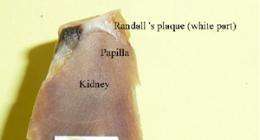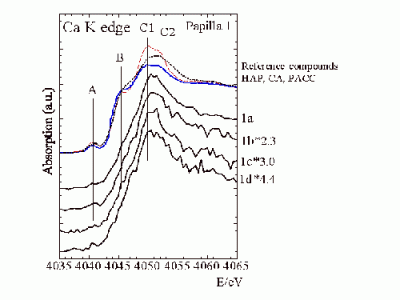In the photo the Randall plaque can be clearly seen as the white part at the top of the renal papilla. Copyright: X. Carpentier et al., 2010.
Randall's plaques are soft tissue calcifications found in the deep renal medulla skirting the surface of the epithelium of the papilla, where they act as nucleating elements for renal calculi or stones. These plaques have been described until now as composed of carbapatite (poorly crystallized carbonated calcium phosphate or carbonated apatite, abbreviated to CA). Characterization of these plaques in real environments has led to more surprising results.
A group consisting of physicists from the Laboratoire de Physique des Solides and the DIFFABS beamline at SOLEIL, in collaboration with doctors at the Necker Hospital, have carried out for the first time the characterization of a Randall plaque positioned on its renal papilla. More precisely, they carried out X-ray absorption spectroscopy experiments at the Ca K-edge on DIFFABS.
The researchers were able to study the exact nature and proportions of the mineral phases present in the Randall plaque when moving from the top of the papilla towards the deep medulla without the need for preparation protocols that might alter the sample’s physicochemical state. They then showed that the absorption spectra obtained looked more like that of amorphous carbonated calcium phosphate (ACCP) than that of CA, therefore revealing that Randall plaques could be composed mainly of ACCP and not of CA.
Spectrum: XANES part of the absorption spectra for the papilla 1. Copyright: X. Carpentier et al., 2010.
This result, in apparent contradiction to that stated in published literature, is easily explained if one takes into account the fact that the level of water in the sample governs the transition between ACCP and CA, of which it is the precursor. In earlier studies, the samples were dehydrated, which could have modified the phase transition from ACCP to CA, whereas, in these experiments, the water levels were maintained; the Randall plaque could then be characterized while keeping its physicochemistry intact.
It should be noted that ACCP is evidence of an oversaturation in calcium phosphate by an excess of calcium and/or phosphate and/or due to too high a pH. Its presence in increasingly young subjects raises the question: does nutrient-enriched food specially aimed at young children affect the physiology of the kidney? The debate is open.
More information: The pathogenesis of Randall's plaque: a papilla cartography of Ca compounds through an ex vivo investigation based on XANES spectroscopy, The Journal of Synchrotron Radiation (2010). 17, 374-379. DOI:10.1107/S0909049510003791
Provided by SOLEIL




















